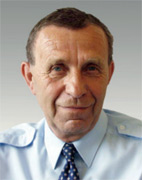
Vladimír Dvořák (1934–2007)
Významný český vědec, který pracoval ve fyzice pevných látek. Zabýval se teorií feroelektrických látek a strukturálních fázových přechodů. Celý svůj produktivní život spojil s Fyzikálním ústavem. Byl jeho ředitelem v letech 1993-2001. Členem Učené společnosti byl od r. 1995. Byl protagonistou revolučních reforem ve Fyzikálním ústavu po roce 1989. K uctění této osobnosti a jeho práce organizuje Fyzikální ústav každoročně slavnostní Dvořákovu přednášku, přednesenou mezinárodně uznávanou autoritou v některém z oborů výzkumu Fyzikálního ústavu.
St, 04/06/2014 - 15:00
Orazio Svelto (Politecnico di Milano, Italy)
St, 12/06/2013 - 15:00 - 16:00
Peter Jenni (University of Freiburg, Germany and CERN, Geneva, Switzerland)
St, 06/06/2012 - 15:00 - 16:30
Prof. Allan H. MacDonald (University of Texas at Austin, USA)
St, 08/06/2011 - 15:00 - 17:00
Prof. Dieter Vollhardt (University of Augsburg, Germany)
St, 23/06/2010 - 15:00 - 17:00
Prof. Anton Zeilinger (University of Vienna, Austria)
St, 10/06/2009 - 15:00 - 18:00
Prof. Yoshihiro Ishibashi (Nagoya University, Japan)
Copyright © 2008-2010, Fyzikální ústav AV ČR, v. v. i.